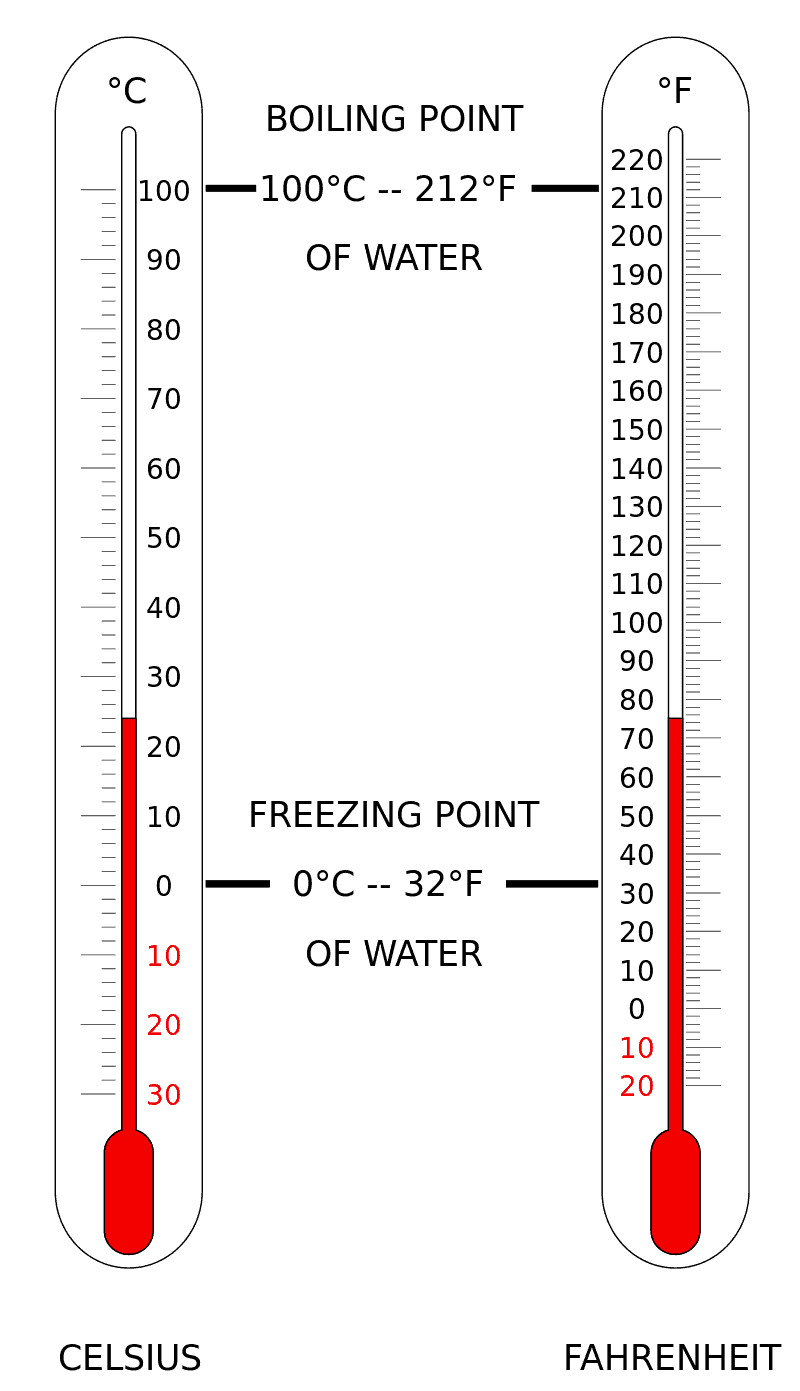Most countries officially use the Celsius temperature scale. However, the United-States still use the Fahrenheit scale, even though scientists prefer to use Kelvin or Celsius. This Fahrenheit temperature scale is used for weather forecasts, cooking temperatures, etc. It is therefore important to know how to do Celsius to Fahrenheit conversion.
Table of Contents
Conversion Formula
[°F] = [°C] × 1.8 + 32
… or if you prefer using a fraction
[°F] = [°C] × 9⁄5 + 32
The Celsius to Fahrenheit conversion requires a simple equation. To obtain a Fahrenheit value, you must first multiply the Celsius value by 1.8 (or the fraction 9/5), then add 32. The order of these operations is important. You must perform the multiplication before the addition to convert Celsius to Fahrenheit.
Celsius to Fahrenheit Chart
As you can see, plotting Fahrenheit temperature as a function of Celsius degrees gives a linear equation. Alternatively, you can use such a chart to easily convert Celsius to Fahrenheit.
Example – Convert 5 Celsius to Fahrenheit
Let’s say that you want to convert 5 Celsius to Fahrenheit. The first step is to multiply 5 by 1.8 to obtain 9. Then, you take this result of 9 and add 32 to determine that 5 degrees Celsius is the equivalent of 41 Fahrenheit.
This formula can precisely convert Celsius to Fahrenheit, but it is not trivial to perform fast mental calculations. Alternatively, you can estimate a Fahrenheit value by multiplying the Celsius value by 2 before adding 32 degrees. Using the same example, the estimation for 5 Celsius is 42 Fahrenheit. In addition, this estimation is very close to the exact value of 41 degrees.
0° Celsius to Fahrenheit
The Celsius temperature scale arbitrary sets the freezing point of water as 0° Celsius. The conversion of 0° Celsius to Fahrenheit gives 32 degrees. As a result, the 0 degree Fahrenheit was instead set to reflect the freezing temperature of… a mixture of ice, water and salt. Of course, this is not the most convenient reference point to set up a temperature scale. Nevertheless, the freezing temperature of this mixture is set using this scale to 0 Fahrenheit which converts to -32 Celsius.
100 Celsius to Fahrenheit
The Celsius temperature scale sets the boiling temperature of water to 100° Celsius. The conversion of 100 Celsius to Fahrenheit gives 212 degrees. Therefore, the boiling point of water is 212 Fahrenheit.
Celsius to Fahrenheit Table
Conversion table (-30 to 40 Celsius) – Useful for Weather Temperature Conversion
| Celsius | Fahrenheit |
|---|---|
| -30 | -22 |
| -29 | -20.2 |
| -28 | -18.4 |
| -27 | -16.6 |
| -26 | -14.8 |
| -25 | -13 |
| -24 | -11.2 |
| -23 | -9.4 |
| -22 | -7.6 |
| -21 | -5.8 |
| -20 | -4 |
| -19 | -2.2 |
| -18 | -0.4 |
| -17 | 1.4 |
| -16 | 3.2 |
| -15 | 5 |
| -14 | 6.8 |
| -13 | 8.6 |
| -12 | 10.4 |
| -11 | 12.2 |
| -10 | 14 |
| -9 | 15.8 |
| -8 | 17.6 |
| -7 | 19.4 |
| -6 | 21.2 |
| -5 | 23 |
| -4 | 24.8 |
| -3 | 26.6 |
| -2 | 28.4 |
| -1 | 30.2 |
| 0 | 32 |
| 1 | 33.8 |
| 2 | 35.6 |
| 3 | 37.4 |
| 4 | 39.2 |
| 5 | 41 |
| 6 | 42.8 |
| 7 | 44.6 |
| 8 | 46.4 |
| 9 | 48.2 |
| 10 | 50 |
| 11 | 51.8 |
| 12 | 53.6 |
| 13 | 55.4 |
| 14 | 57.2 |
| 15 | 59 |
| 16 | 60.8 |
| 17 | 62.6 |
| 18 | 64.4 |
| 19 | 66.2 |
| 20 | 68 |
| 21 | 69.8 |
| 22 | 71.6 |
| 23 | 73.4 |
| 24 | 75.2 |
| 25 | 77 |
| 26 | 78.8 |
| 27 | 80.6 |
| 28 | 82.4 |
| 29 | 84.2 |
| 30 | 86 |
| 31 | 87.8 |
| 32 | 89.6 |
| 33 | 91.4 |
| 34 | 93.2 |
| 35 | 95 |
| 36 | 96.8 |
| 37 | 98.6 |
| 38 | 100.4 |
| 39 | 102.2 |
| 40 | 104 |
Conversion table (120 to 260 Celsius) – Useful for Kitchen Temperature Conversion
| Celsius | Fahrenheit |
|---|---|
| 120 | 248 |
| 125 | 257 |
| 130 | 266 |
| 135 | 275 |
| 140 | 284 |
| 145 | 293 |
| 150 | 302 |
| 155 | 311 |
| 160 | 320 |
| 165 | 329 |
| 170 | 338 |
| 175 | 347 |
| 180 | 356 |
| 185 | 365 |
| 190 | 374 |
| 195 | 383 |
| 200 | 392 |
| 205 | 401 |
| 210 | 410 |
| 215 | 419 |
| 220 | 428 |
| 225 | 437 |
| 230 | 446 |
| 235 | 455 |
| 240 | 464 |
| 245 | 473 |
| 250 | 482 |
| 255 | 491 |
| 260 | 500 |
Did you find this information useful? Don’t hesitate to leave a comment down below!
Check also my previous post to learn more about the scientific method or to see how does a Crookes radiometer work.
References
1- Wikipedia – Farhenheit.
2- Wikipedia – 0 Fahrenheit is the freezing point of brine.

